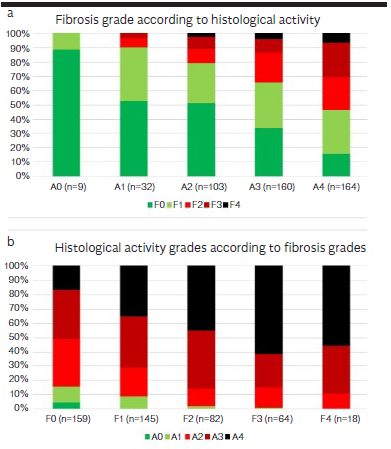Background/Aims: Nonalcoholic fatty liver disease (NAFLD), which consists of nonalcoholic fatty liver (NAFL) and nonalcoholic steatohepatitis (NASH), is a growing epidemic in Turkey, considering the recent alarming prevalence of 48.3%. Patients with NASH and/or liver fibrosis are more likely to progress to advanced liver disease. In this single-center study, we sought to describe the clinical and histological characteristics of a sample of Turkish patients with biopsy-proven NAFLD, who were enrolled over a 4-year period.
Materials and Methods: This is a retrospective analysis of prospectively collected data from a total of 468 patients (224 males, 244 females; median age, 47 [18-71]. The study cohort consisted of patients with biopsy-proven NAFLD who were followed up at our outpatient clinic from 2009 to 2010 and from 2017 to 2018. Histological classification of the biopsies was performed according to the Steatosis, Activity and Fibrosis (SAF) scoring allowing the use of Fatty Liver Inhibition of Progression (FLIP) algorithm and the NAFLD Activity Score (NAS) scoring system.
Results: Based on the SAF scoring, most patients (90.4%) had biopsy-proven NASH, whereas the NAFL was much rarer (9.6%). The prevalence of significant fibrosis (≥F2), advanced fibrosis (≥F3), and cirrhosis (F=4) was 35.0%, 17.5%, and 3.8%, respectively. The percentage of lean, overweight, and obese patients with NAFLD was 6.4%, 32.6%, and 61%, respectively. Metabolic syndrome was prevalent in 63% of the patients and Type 2 diabetes mellitus in 33.5%.
Conclusion: The growing burden of NAFLD as a public health problem in Turkey is underscored by its marked histological severity in terms of NASH and fibrosis. Well-conducted clinical trials will be essential for slowing down the NASH progression.
Cite this article as: Yılmaz Y, Kanı HT, Demirtaş CÖ, et al. Growing burden of nonalcoholic fatty liver disease in Turkey: A single-center experience. Turk J Gastroenterol 2019; 30(10): 892-8.




.png)
.png)
